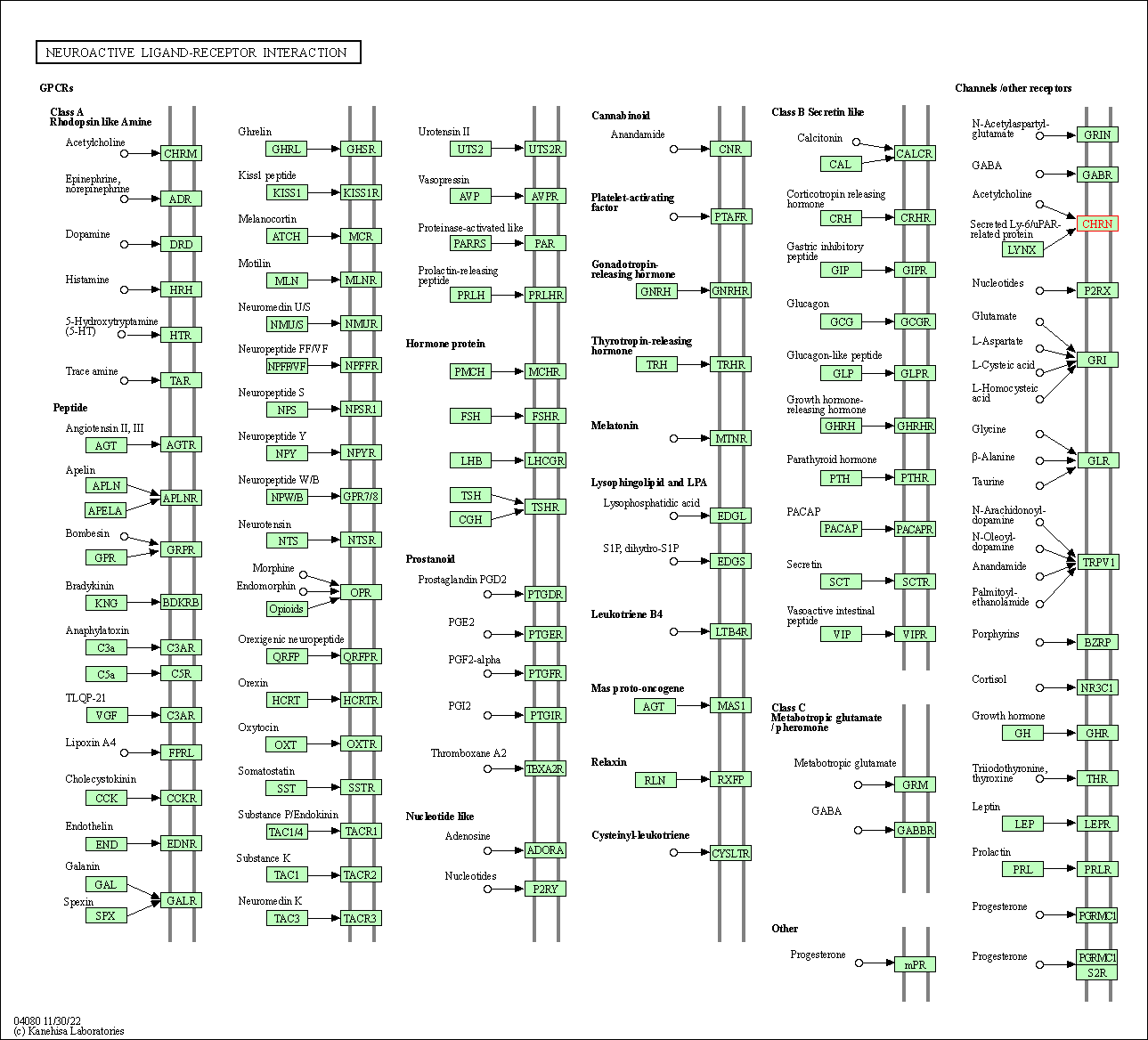Target Information
| Target General Information | Top | |||||
|---|---|---|---|---|---|---|
| Target ID |
T00299
(Former ID: TTDR01260)
|
|||||
| Target Name |
Neuronal acetylcholine receptor alpha-5 (CHRNA5)
|
|||||
| Synonyms |
NACHRA5; CHRNA5
Click to Show/Hide
|
|||||
| Gene Name |
CHRNA5
|
|||||
| Target Type |
Literature-reported target
|
[1] | ||||
| Function |
After binding acetylcholine, the AChR responds by an extensive change in conformation that affects all subunits and leads to opening of an ion-conducting channel across the plasma membrane.
Click to Show/Hide
|
|||||
| BioChemical Class |
Neurotransmitter receptor
|
|||||
| UniProt ID | ||||||
| Sequence |
MAARGSGPRALRLLLLVQLVAGRCGLAGAAGGAQRGLSEPSSIAKHEDSLLKDLFQDYER
WVRPVEHLNDKIKIKFGLAISQLVDVDEKNQLMTTNVWLKQEWIDVKLRWNPDDYGGIKV IRVPSDSVWTPDIVLFDNADGRFEGTSTKTVIRYNGTVTWTPPANYKSSCTIDVTFFPFD LQNCSMKFGSWTYDGSQVDIILEDQDVDKRDFFDNGEWEIVSATGSKGNRTDSCCWYPYV TYSFVIKRLPLFYTLFLIIPCIGLSFLTVLVFYLPSNEGEKICLCTSVLVSLTVFLLVIE EIIPSSSKVIPLIGEYLVFTMIFVTLSIMVTVFAINIHHRSSSTHNAMAPLVRKIFLHTL PKLLCMRSHVDRYFTQKEETESGSGPKSSRNTLEAALDSIRYITRHIMKENDVREVVEDW KFIAQVLDRMFLWTFLFVSIVGSLGLFVPVIYKWANILIPVHIGNANK Click to Show/Hide
|
|||||
| 3D Structure | Click to Show 3D Structure of This Target | AlphaFold | ||||
| HIT2.0 ID | T16R2S | |||||
| Cell-based Target Expression Variations | Top | |||||
|---|---|---|---|---|---|---|
| Cell-based Target Expression Variations | ||||||
| Different Human System Profiles of Target | Top |
|---|---|
|
Human Similarity Proteins
of target is determined by comparing the sequence similarity of all human proteins with the target based on BLAST. The similarity proteins for a target are defined as the proteins with E-value < 0.005 and outside the protein families of the target.
A target that has fewer human similarity proteins outside its family is commonly regarded to possess a greater capacity to avoid undesired interactions and thus increase the possibility of finding successful drugs
(Brief Bioinform, 21: 649-662, 2020).
Human Pathway Affiliation
of target is determined by the life-essential pathways provided on KEGG database. The target-affiliated pathways were defined based on the following two criteria (a) the pathways of the studied target should be life-essential for both healthy individuals and patients, and (b) the studied target should occupy an upstream position in the pathways and therefore had the ability to regulate biological function.
Targets involved in a fewer pathways have greater likelihood to be successfully developed, while those associated with more human pathways increase the chance of undesirable interferences with other human processes
(Pharmacol Rev, 58: 259-279, 2006).
Human Similarity Proteins
Human Pathway Affiliation
|
|
|
There is no similarity protein (E value < 0.005) for this target
|

| KEGG Pathway | Pathway ID | Affiliated Target | Pathway Map |
|---|---|---|---|
| Neuroactive ligand-receptor interaction | hsa04080 | Affiliated Target |

|
| Class: Environmental Information Processing => Signaling molecules and interaction | Pathway Hierarchy | ||
| Target Affiliated Biological Pathways | Top | |||||
|---|---|---|---|---|---|---|
| NetPath Pathway | [+] 1 NetPath Pathways | + | ||||
| 1 | TCR Signaling Pathway | |||||
| Panther Pathway | [+] 2 Panther Pathways | + | ||||
| 1 | Nicotinic acetylcholine receptor signaling pathway | |||||
| 2 | Nicotine pharmacodynamics pathway | |||||
| Reactome | [+] 2 Reactome Pathways | + | ||||
| 1 | Highly calcium permeable postsynaptic nicotinic acetylcholine receptors | |||||
| 2 | Highly calcium permeable nicotinic acetylcholine receptors | |||||
| WikiPathways | [+] 2 WikiPathways | + | ||||
| 1 | Neurotransmitter Receptor Binding And Downstream Transmission In The Postsynaptic Cell | |||||
| 2 | Nicotine Activity on Dopaminergic Neurons | |||||
| References | Top | |||||
|---|---|---|---|---|---|---|
| REF 1 | URL: http://www.guidetopharmacology.org Nucleic Acids Res. 2015 Oct 12. pii: gkv1037. The IUPHAR/BPS Guide to PHARMACOLOGY in 2016: towards curated quantitative interactions between 1300 protein targets and 6000 ligands. (Target id: 466). | |||||
If You Find Any Error in Data or Bug in Web Service, Please Kindly Report It to Dr. Zhou and Dr. Zhang.

